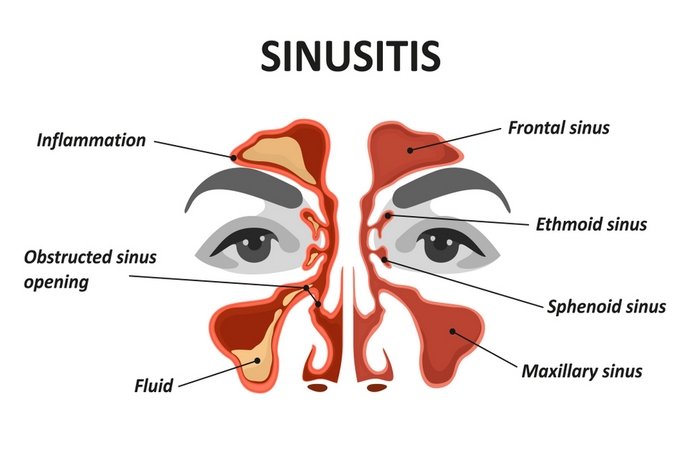Sinus Infection
Sinus infection is a swelling or inflammation in the tissue lining. Sinuses are the empty spaces that occur within the bones between the eye, back of your cheekbones, and in the forehead. They form mucus that keeps your nose moist from inside. That, in reserve, aids in protecting against pollutants, allergens, and dust. Healthy sinuses are being filled with air. But when they get filled and blocked with germs, fluids might grow and lean with an infection. (1)
Conditions that might lead to sinus blockage consist of:
- Allergic rhinitis that is swelling in the lining of the led by allergens
- The common cold
- A deviated septum that transfer in the nasal cavity
- Small growth in the nose lining known as nasal polyps
Sinusitis is a swelling or an inflammation of the tissues lining the sinuses. The sinuses are the four spaces (cavities) that are in pairs in the head. They get connected by small channels. The sinuses form thin mucus that diminishes from the channels of the nose. This drainage aids in keeping your nose free and clean from bacteria. Normally it fills with air; the sinuses get blocked and fill with fluid. When it occurs, bacteria might grow and lead to an infection (bacterial sinusitis). It is also known as rhinosinusitis with the meaning of rhino is the nose. The nasal tissue is swollen most of the time if sinus tissue has inflammation.

The paranasal sinuses are present in your head close to your eyes and nose. They are called after the bones that give their structure.
- The frontal sinuses are present above your eyes
- The ethmoidal sinuses are present between the eyes
- While the sphenoidal sinuses are present in the back of your eyes
- The maxillary sinuses occur below your eyes
The huge sinus cavity is known as the maxillary cavity and it is one of the spaces that sometimes get infected. The infection of the sinus might occur to anyone. Therefore, individuals having nasal polyps, abnormal structure of nose, asthma, nasal allergies are all more likely to have sinusitis. Smoking might also rise to how you sometimes have a sinus infection. There is an estimation around 31 million individuals in the United States suffer from sinusitis.
There are different kinds of sinusitis:
- Chronic sinusitis: This term mentions a situation known as drainage, nasal congestion, facial pressure/pain, and lower sense of smell for almost 12 weeks.
- Acute bacterial sinusitis: Such term refers to the onset of symptoms of cold suddenly such as stuffy nose, runny nose, and facial pain that does not vanish away after 10 days, or the symptoms do not appear to enhance but then return and get worse than the starting symptoms (called as “double sickening”). It acts well as decongestants and antibiotics.
- Recurrent acute sinusitis: Such terms use when the symptoms appear again four or more times in each year and stay less than two weeks per time.
- Subacute sinusitis: This term is used when the symptoms stay from four to twelve weeks.

